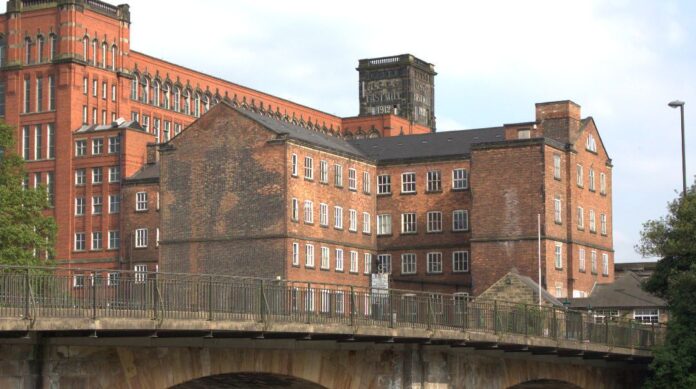Before the Covid-19 pandemic, the Strutt North Mill Museum, a historic 19th century textile mills located in Derbyshire’s picturesque Derwent Valley Mills World Heritage Site, attracted up 4,000 visitors a year.
The small museum houses a collection that includes a spinning mule, used to spin cotton, and an early mechanical knitting machine, as well as ephemera and objects such as handmade hosiery once worn by King George III and Queen Victoria. The museum preserved an important piece of the region’s local industrial history.
But in April this year the Strutt announced it would be permanently closing its doors to the public in September after losing a grant to the tune of £50,000 from the Amber Valley District Council, as part of the UK Budget Reduction Plan introduced in the wake of the pandemic.
John Layton, chairman of the Belper North Mill Trust, said the museum was “a very much loved local landmark” but that they had not been able to secure further public money because they do not own the building. “We are living in difficult economic times and there’s no easy solution,” he told The Art Newspaper.
Without funding, the museum is caught in a catch 22, unable to invest in improvements needed to boost visitor numbers to create more secure income streams less reliant on grants. A Labour MP on the Amber Valley District Council called the closure “an insult to local people past and present whose heritage and culture was celebrated in the museum.”
The Strutt North Mill Museum is one of many regional museum and heritage sites across the UK that has struggled during the pandemic, when national closures fell during the peak season between Easter and September—a time when heritage sites anticipate earning 70% of their annual turnover. Some heritage charities, according to Heritage Alliance, have seen their non-grant income fall by up to 90% over the last two years.
Future remains unclear
While many heritage sites have steadily re-opened, there are now new challenges to face: the impact of the current cost of living crisis, loss of staff and public engagement, and rising fuel and energy prices are still yet uncertain, and the future for many is unclear.
Anne Young, the director of strategy and innovation at the Heritage Fund— one of the key funders of the UK’s heritage projects—framed the situation the sector is facing unequivocally as the “gravest threat since the Second World War”.
In May, Art Fund published the results of their nationwide museum directors report, compiled from responses from 200 directors across the country. The outlook remains grim, with the cost of living crisis posing a looming threat and challenge to both staff and audiences, while emergency funding made available during the pandemic no longer accessible.
“The true impact of past cuts and future losses will be felt sharply and deeply,” the Art Fund report says. “The cost of living crisis looms large in discussions about staffing, with concerns particularly focused on the lowest paid staff and those living in rural areas needing to commute to work.” Meanwhile, the data reports reduced visitor numbers for 2021-2022: down 39% compared to pre-pandemic figures.
Cautious optimism and resilience
Yet despite this, others are cautiously optimistic. Respondents to the first survey sent in February 2022 as part of a new directive launched by the National Lottery Heritage Fund, UK Heritage Pulse project, were surprisingly positive. Of 277 respondents (a number that is indicative rather than comprehensively representative), confidence in survival over the next six months averaged 4.3 out of 5. This is a vastly differently outlook to a similar survey conducted by the organisation in 2020, when 37% of respondents felt they would not survive more than six months.
It may be the case that the true effects of the current crisis are not yet being felt—but the pandemic has perhaps made organisations more resilient and adaptable. A spokesperson at English Heritage, a charity responsible for over 400 monuments, buildings and sites across England, including Stone Henge, Hadrian’s Wall and Dover Castle, reflected a similar sentiment.
“We’re not seeing any immediate impact, although it’s something we are monitoring very closely. In terms of visitors to our sites, we’ve had a relatively positive start to the financial year, but it is early days, people are still making their plans as to how they’re going to spend their time—and money. Rising fuel prices may mean reduced numbers at those sites that can only be reached by car or a delay in the recovery of inbound tourism. However, some of that risk may be mitigated by the fact that the current airport disruption might encourage domestic visits while the weaker pound sterling might improve the UK’s attraction as an international holiday destination.”
In 2021, in addition to a surge in memberships, English Heritage saw an increased number of visitors at smaller, local sites such as Barnard Castle in Durham, Boscobel House, Shropshire, and Wrest Park, Bedfordshire, which recorded its highest visitor numbers to date.
The support of the local community seems paramount to an organisation’s success. On 15 June, Colchester Museums announced that a planned exhibition on witchcraft and magic at Colchester Castle could go ahead thanks to a crowdfunding campaign that raised more than £15,000. The majority 200 donors were local people who contributed even “at a time of great financial hardship for many families,” says Pamela Cox, Colchester Borough Council member.
Ultimately, economic instability and global politics might be driving a shift in perception of local heritage sites and their importance as part of the social fabric and identity of communities where people are increasingly rooted and invested. As English Heritage suggests: “These are the places where history happened; these historic sites bring us solace and refreshment, because they have survived, because they’re still standing—and because the stories they tell us help give perspective in uncertain times.”

























